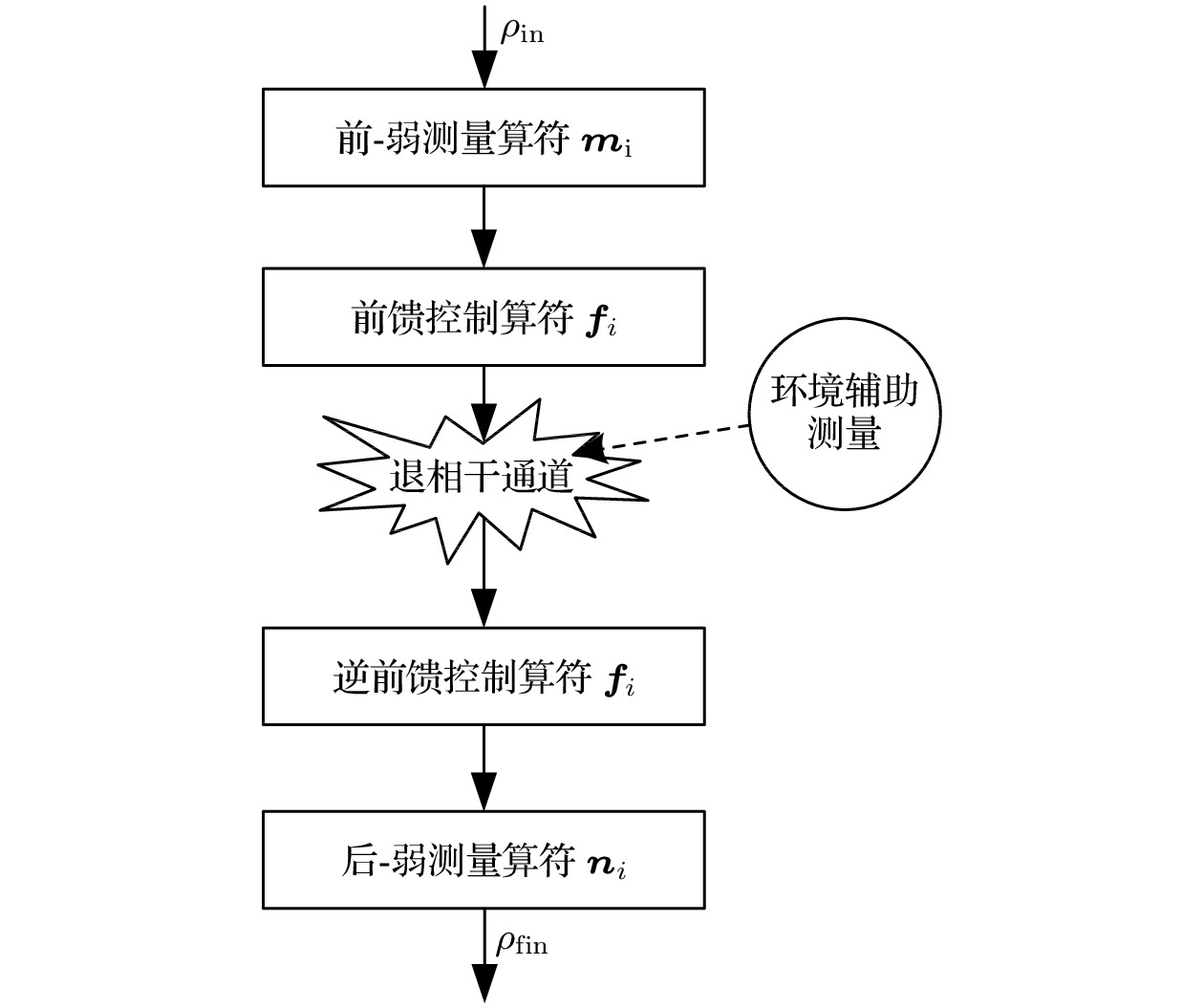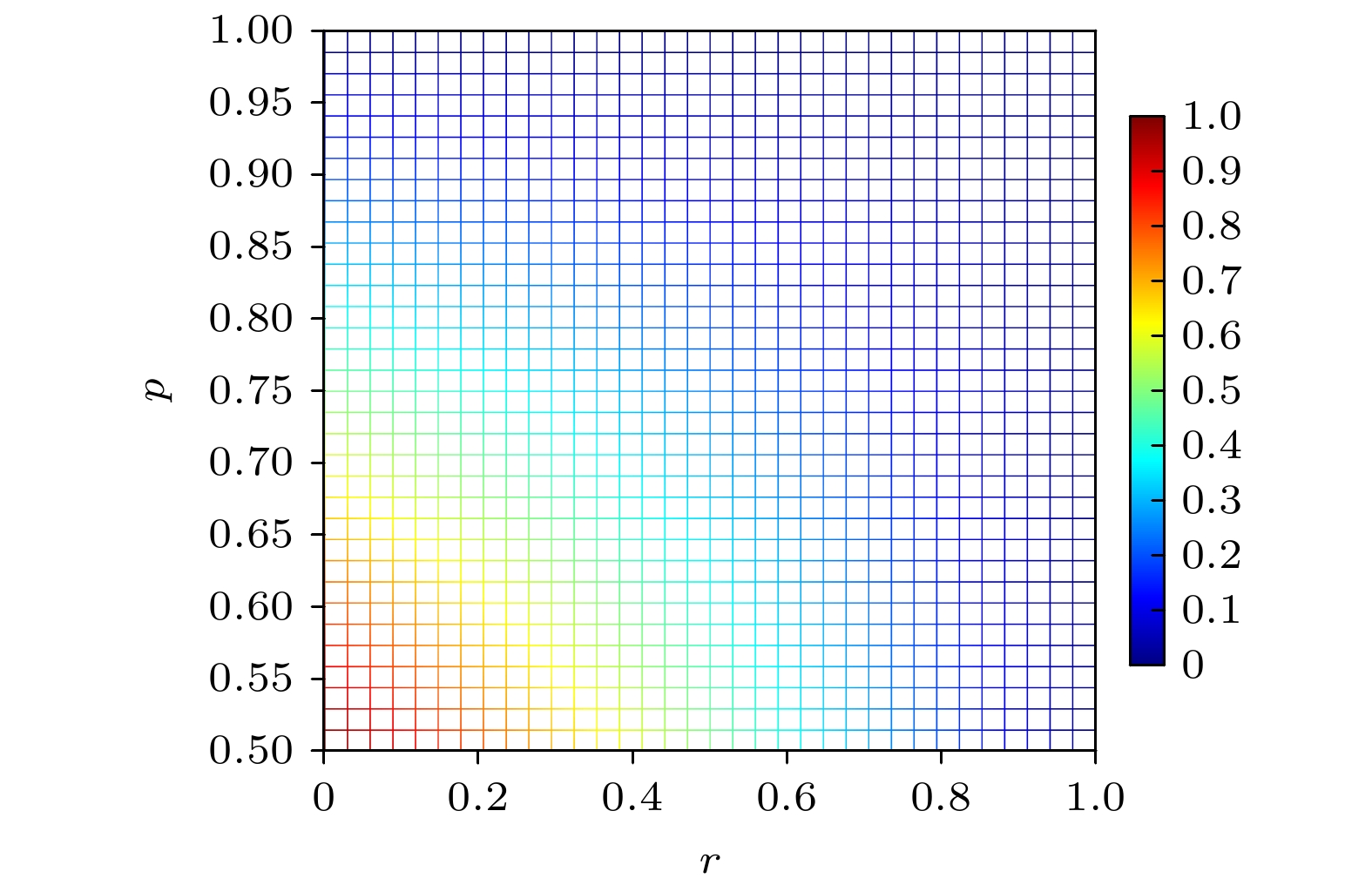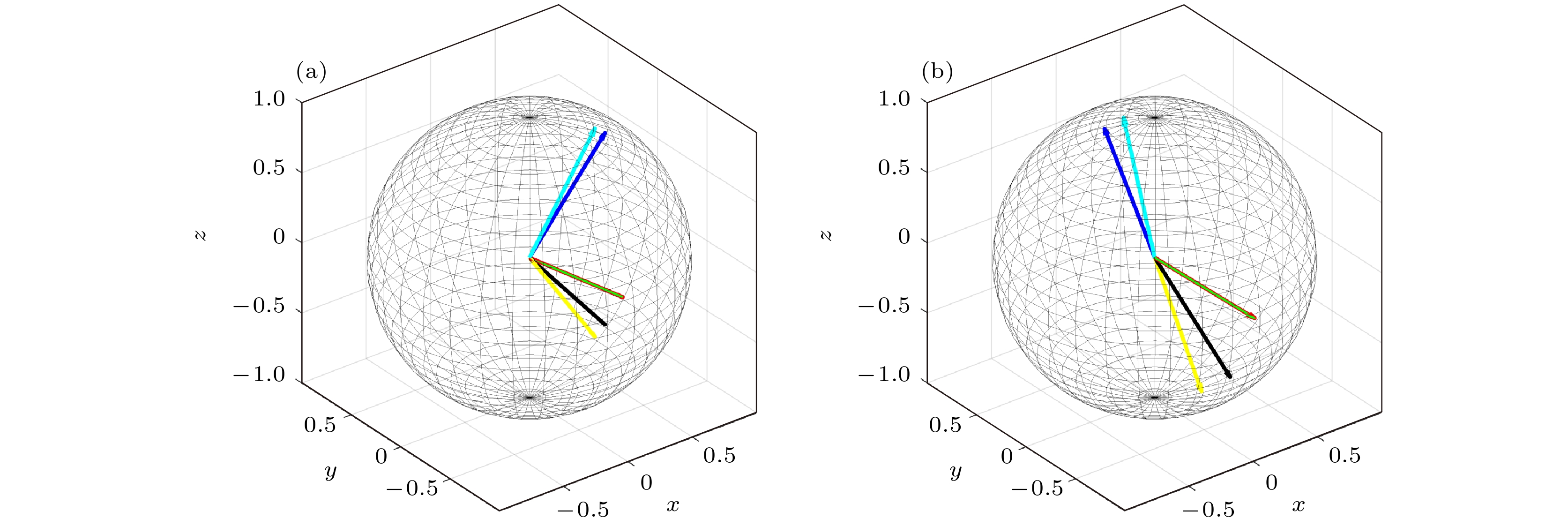-
退相干抑制是量子系统控制中一项重要的控制任务. 受到经典控制理论中的前馈控制的启发, 本文借助弱测量和环境辅助测量提出一种新的退相干抑制方案, 并将其推广到一般的N量子比特情形. 所提方案的核心思想是: 在退相干通道前, 借助弱测量算符和前馈控制算符将量子比特转移到一个对环境噪声更鲁棒的状态上; 在退相干通道中, 对与被保护的量子比特耦合的环境进行测量; 在退相干通道后, 再借助相应的反转算符恢复初始状态. 所提方案适用于具有至少一个可逆的Kraus算符的任意退相干通道下的量子状态保护. 假设所考虑的振幅阻尼或相位阻尼退相干通道的特性是完全已知的, 那么所提方案即便是在重阻尼情况下也能取得100%的保真度, 这是所提方案的最大优势. 以2量子比特纠缠态的并发度增强和噪声环境下量子隐形传态的保真度提高为例设计了两组数值仿真实验, 推导了性能指标的解析表达式, 并通过与无保护方案对比凸显出所提方案的优越性.All open quantum systems are affected by environmental noises due to their interactions with the external environment and inevitably suffer from decoherence. Hence, it is fundamentally important and necessary to investigate decoherence suppression for open quantum systems via proper control strategies. Inspired by feed-forward control in the classical control theory, this paper proposes a novel decoherence suppression scheme via weak measurement and environment-assisted measurement. We first take the single-qubit system as an example to illustrate steps of the proposed scheme. To be specific, the single-qubit system is transferred to a state that is more robust to environmental noises via pre-weak measurement operators and feed-forward control operators before the decoherence channel, a measurement is performed on the environment coupled to the protected qubit during the decoherence channel, and the initial state is recovered via reversed feed-forward control operators and post-weak measurement operators after the decoherence channel. The optimum post-weak measurement strength is derived by setting the normalized final state equal to the initial state. By considering the optimum post-weak measurement strength, analytical formulas of the total success probability and the total fidelity are deduced. The proposed scheme is applicable for protecting quantum states from arbitrary decoherence channels with at least one invertible Kraus operator although only the amplitude damping channel and the phase damping channel are taken into account. Provided that the decay rate of the amplitude or phase damping channel is completely known, one can always achieve unit fidelity even for heavy damping cases, which is the biggest advantage of the proposed scheme. Influences of several parameters including strengths of weak measurements, the initial state and the decay rate of the decoherence channel on the performance of decoherence suppression are analyzed, and detailed procedures of a single-qubit pure and mixed state protection are presented on the Bloch sphere, respectively. Subsequently, the Kronecker product is employed to construct operators of dimension
$ 2^N \times 2^N$ , the proposed scheme is extended to the general N-qubit case, and unified analytical formulas of the total success probability and the total fidelity are deduced. By applying the proposed scheme to the protection of two-qubit entangled states, it is demonstrated that post-weak measurement operators are not necessary sometimes because of the particular structure of two-qubit entangled states. Furthermore, two numerical simulations are designed to enhance the concurrence of two-qubit entangled states and improve the average fidelity of the standard quantum teleportation in a noisy environment. Analytical formulas of the improvement of concurrence and the average teleportation fidelity are deduced, and the superiority of the proposed scheme is highlighted in comparison with unprotected scenarios.-
Keywords:
- decoherence suppression /
- quantum feed-forward control /
- weak measurement /
- environment-assisted measurement
[1] 丛爽, 匡森 2020 量子系统控制理论与方法 (合肥: 中国科学技术大学出版社) 第32–33页
Cong S, Kuang S 2020 Control Theory and Methods of Quantum Systems (Hefei: Press of University of Science and Technology of China) pp32–33 (in Chinese)
[2] Cardoso E S, de Oliveira M D, Furuya K 2005 Phys. Rev. A 72 042320
 Google Scholar
Google Scholar
[3] Fan H Y, Hu L Y 2009 Opt. Commun. 282 932
 Google Scholar
Google Scholar
[4] 刘其功, 计新 2012 物理学报 61 230303
 Google Scholar
Google Scholar
Liu Q G, Ji X 2012 Acta Phys. Sin. 61 230303
 Google Scholar
Google Scholar
[5] Piao M Z, Ji X 2012 J. Mod. Opt. 59 21
 Google Scholar
Google Scholar
[6] Jahangir R, Arshed N, Toor A H 2015 Quantum Inf. Process. 14 765
 Google Scholar
Google Scholar
[7] 杨光, 廉保旺, 聂敏 2015 物理学报 64 010303
 Google Scholar
Google Scholar
Yang G, Lian B W, Nie M 2015 Acta Phys. Sin. 64 010303
 Google Scholar
Google Scholar
[8] D'Arrigo A, Benenti G, Falci G, Macchiavello C 2015 Phys. Rev. A 92 062342
 Google Scholar
Google Scholar
[9] 胡强, 曾柏云, 辜鹏宇, 贾欣燕, 樊代和 2022 物理学报 71 070301
 Google Scholar
Google Scholar
Hu Q, Zeng B Y, Gu P Y, Jia X Y, Fan D H 2022 Acta Phys. Sin. 71 070301
 Google Scholar
Google Scholar
[10] Harraz S, Cong S, Nieto J J 2022 Int. J. Quantum Inf. 20 2250007
 Google Scholar
Google Scholar
[11] Lidar D A, Chuang I L, Whaley K B 1998 Phys. Rev. Lett. 81 2594
 Google Scholar
Google Scholar
[12] Kempe J, Bacon D, Lidar D A, Whaley K B 2001 Phys. Rev. A 63 392
 Google Scholar
Google Scholar
[13] Kwiat P G, Berglund A J, Altepeter J B, White A G 2000 Science 290 498
 Google Scholar
Google Scholar
[14] Chen M, Kuang S, Cong S 2017 J. Franklin Inst. 354 439
 Google Scholar
Google Scholar
[15] Steane A M 1996 Phys. Rev. Lett. 77 793
 Google Scholar
Google Scholar
[16] Cramer J, Kalb N, Rol M A, Hensen B, Blok M S, Markham M, Twitchen D J, Hanson R, Taminian T H 2016 Nat. Commun. 7 11526
 Google Scholar
Google Scholar
[17] Ofek N, Petrenko A, Heeres R, Reinhold P, Leghtas Z, Vlastakis B, Liu Y, Frunzio L, Girvin S M, Jiang L, Mirrahimi M, Devoret M H, Schoelkopf R J 2016 Nature 536 441
 Google Scholar
Google Scholar
[18] Viola L, Lloyd S 1998 Phys. Rev. A 58 2733
 Google Scholar
Google Scholar
[19] Viola L, Knill E, Lloyd S 1999 Phys. Rev. Lett. 82 2417
 Google Scholar
Google Scholar
[20] Du J, Rong X, Zhao N, Wang Y, Yang J, Liu R B 2009 Nature 461 1265
 Google Scholar
Google Scholar
[21] 汪野, 张静宁, 金奇奂 2019 物理学报 68 030306
 Google Scholar
Google Scholar
Wang Y, Zhang J N, Kim K 2019 Acta Phys. Sin. 68 030306
 Google Scholar
Google Scholar
[22] Branczyk A M, Mendonca P E M F, Gilchrist A, Doherty A C, Bartlett S D 2007 Phys. Rev. A 75 012329
 Google Scholar
Google Scholar
[23] Gillett G G, Dalton R B, Lanyon B P, Almeida M P, Barbieri M, Pryde G J, O'Brien J L, Resch K J, Bartlett S D, White A G 2010 Phys. Rev. Lett. 104 080503
 Google Scholar
Google Scholar
[24] Korotkov A N, Keane K 2010 Phys. Rev. A 81 040103
 Google Scholar
Google Scholar
[25] 黄江 2017 物理学报 66 010301
 Google Scholar
Google Scholar
Huang J 2017 Acta Phys. Sin. 66 010301
 Google Scholar
Google Scholar
[26] Wang C Q, Xu B M, Zou J, He Z, Yan Y, Li J G, Shao B 2014 Phys. Rev. A 89 032303
 Google Scholar
Google Scholar
[27] Harraz S, Cong S, Li K 2020 Quantum Inf. Process. 19 250
 Google Scholar
Google Scholar
[28] Harraz S, Cong S, Kuang S 2019 J. Syst. Sci. Complex. 32 1264
 Google Scholar
Google Scholar
[29] Gregoratti M, Werner R F 2003 J. Mod. Opt. 50 915
 Google Scholar
Google Scholar
[30] Wang K, Zhao X, Yu T 2014 Phys. Rev. A 89 042320
 Google Scholar
Google Scholar
[31] Xu X M, Cheng L Y, Liu A P, Su S L, Wang H F, Zhang S 2015 Quantum Inf. Process. 14 4147
 Google Scholar
Google Scholar
[32] Wu H J, Jin Z, Zhu A D 2018 Int. J. Theor. Phys. 57 1235
 Google Scholar
Google Scholar
[33] Harraz S, Cong S, Nieto J J 2021 Eur. Phys. J. Plus 136 851
 Google Scholar
Google Scholar
[34] Nielsen M A, Chuang I L 2010 Quantum Computation and Quantum Information (New York: Cambridge University Press) pp26–28
-
图 7
${\rm{fid}}_{{\rm{improve}}({\rm{AD}})}^{(1)}$ 和${\rm{fid}}_{{\rm{improve}}({\rm{PD}})}^{(1)}$ 与初始纯态和r的关系 (a)${\rm{fid}}_{{\rm{improve}}({\rm{AD}})}^{(1)}(|\alpha |, ~r)$ ; (b)${\rm{fid}}_{{\rm{improve}}({\rm{PD}})}^{(1)}(|\alpha |, ~r)$ Fig. 7.
${\rm{fid}}_{{\rm{improve}}({\rm{AD}})}^{(1)}$ and${\rm{fid}}_{{\rm{improve}}({\rm{PD}})}^{(1)}$ are a function of the initial pure state and r: (a)${\rm{fid}}_{{\rm{improve}}({\rm{AD}})}^{(1)}(|\alpha |, ~r)$ ; (b)${\rm{fid}}_{{\rm{improve}}({\rm{PD}})}^{(1)}(|\alpha |, ~r)$ 图 9
$C_{{\rm{improve}}({\rm{AD}})}^{(2)}$ 和$C_{{\rm{improve}}({\rm{PD}})}^{(2)}$ 与初始纠缠态和r的关系 (a)$C_{{\rm{improve}}({\rm{AD}})}^{(2)}(|\alpha |, r)$ ; (b)$C_{{\rm{improve}}({\rm{PD}})}^{(2)}(|\alpha |, r)$ Fig. 9.
$C_{{\rm{improve}}({\rm{AD}})}^{(2)}$ and$C_{{\rm{improve}}({\rm{PD}})}^{(2)}$ are a function of the initial entangled state and r: (a)$C_{{\rm{improve}}({\rm{AD}})}^{(2)}(|\alpha |, r)$ ; (b)$C_{{\rm{improve}}({\rm{PD}})}^{(2)}(|\alpha |, r)$ -
[1] 丛爽, 匡森 2020 量子系统控制理论与方法 (合肥: 中国科学技术大学出版社) 第32–33页
Cong S, Kuang S 2020 Control Theory and Methods of Quantum Systems (Hefei: Press of University of Science and Technology of China) pp32–33 (in Chinese)
[2] Cardoso E S, de Oliveira M D, Furuya K 2005 Phys. Rev. A 72 042320
 Google Scholar
Google Scholar
[3] Fan H Y, Hu L Y 2009 Opt. Commun. 282 932
 Google Scholar
Google Scholar
[4] 刘其功, 计新 2012 物理学报 61 230303
 Google Scholar
Google Scholar
Liu Q G, Ji X 2012 Acta Phys. Sin. 61 230303
 Google Scholar
Google Scholar
[5] Piao M Z, Ji X 2012 J. Mod. Opt. 59 21
 Google Scholar
Google Scholar
[6] Jahangir R, Arshed N, Toor A H 2015 Quantum Inf. Process. 14 765
 Google Scholar
Google Scholar
[7] 杨光, 廉保旺, 聂敏 2015 物理学报 64 010303
 Google Scholar
Google Scholar
Yang G, Lian B W, Nie M 2015 Acta Phys. Sin. 64 010303
 Google Scholar
Google Scholar
[8] D'Arrigo A, Benenti G, Falci G, Macchiavello C 2015 Phys. Rev. A 92 062342
 Google Scholar
Google Scholar
[9] 胡强, 曾柏云, 辜鹏宇, 贾欣燕, 樊代和 2022 物理学报 71 070301
 Google Scholar
Google Scholar
Hu Q, Zeng B Y, Gu P Y, Jia X Y, Fan D H 2022 Acta Phys. Sin. 71 070301
 Google Scholar
Google Scholar
[10] Harraz S, Cong S, Nieto J J 2022 Int. J. Quantum Inf. 20 2250007
 Google Scholar
Google Scholar
[11] Lidar D A, Chuang I L, Whaley K B 1998 Phys. Rev. Lett. 81 2594
 Google Scholar
Google Scholar
[12] Kempe J, Bacon D, Lidar D A, Whaley K B 2001 Phys. Rev. A 63 392
 Google Scholar
Google Scholar
[13] Kwiat P G, Berglund A J, Altepeter J B, White A G 2000 Science 290 498
 Google Scholar
Google Scholar
[14] Chen M, Kuang S, Cong S 2017 J. Franklin Inst. 354 439
 Google Scholar
Google Scholar
[15] Steane A M 1996 Phys. Rev. Lett. 77 793
 Google Scholar
Google Scholar
[16] Cramer J, Kalb N, Rol M A, Hensen B, Blok M S, Markham M, Twitchen D J, Hanson R, Taminian T H 2016 Nat. Commun. 7 11526
 Google Scholar
Google Scholar
[17] Ofek N, Petrenko A, Heeres R, Reinhold P, Leghtas Z, Vlastakis B, Liu Y, Frunzio L, Girvin S M, Jiang L, Mirrahimi M, Devoret M H, Schoelkopf R J 2016 Nature 536 441
 Google Scholar
Google Scholar
[18] Viola L, Lloyd S 1998 Phys. Rev. A 58 2733
 Google Scholar
Google Scholar
[19] Viola L, Knill E, Lloyd S 1999 Phys. Rev. Lett. 82 2417
 Google Scholar
Google Scholar
[20] Du J, Rong X, Zhao N, Wang Y, Yang J, Liu R B 2009 Nature 461 1265
 Google Scholar
Google Scholar
[21] 汪野, 张静宁, 金奇奂 2019 物理学报 68 030306
 Google Scholar
Google Scholar
Wang Y, Zhang J N, Kim K 2019 Acta Phys. Sin. 68 030306
 Google Scholar
Google Scholar
[22] Branczyk A M, Mendonca P E M F, Gilchrist A, Doherty A C, Bartlett S D 2007 Phys. Rev. A 75 012329
 Google Scholar
Google Scholar
[23] Gillett G G, Dalton R B, Lanyon B P, Almeida M P, Barbieri M, Pryde G J, O'Brien J L, Resch K J, Bartlett S D, White A G 2010 Phys. Rev. Lett. 104 080503
 Google Scholar
Google Scholar
[24] Korotkov A N, Keane K 2010 Phys. Rev. A 81 040103
 Google Scholar
Google Scholar
[25] 黄江 2017 物理学报 66 010301
 Google Scholar
Google Scholar
Huang J 2017 Acta Phys. Sin. 66 010301
 Google Scholar
Google Scholar
[26] Wang C Q, Xu B M, Zou J, He Z, Yan Y, Li J G, Shao B 2014 Phys. Rev. A 89 032303
 Google Scholar
Google Scholar
[27] Harraz S, Cong S, Li K 2020 Quantum Inf. Process. 19 250
 Google Scholar
Google Scholar
[28] Harraz S, Cong S, Kuang S 2019 J. Syst. Sci. Complex. 32 1264
 Google Scholar
Google Scholar
[29] Gregoratti M, Werner R F 2003 J. Mod. Opt. 50 915
 Google Scholar
Google Scholar
[30] Wang K, Zhao X, Yu T 2014 Phys. Rev. A 89 042320
 Google Scholar
Google Scholar
[31] Xu X M, Cheng L Y, Liu A P, Su S L, Wang H F, Zhang S 2015 Quantum Inf. Process. 14 4147
 Google Scholar
Google Scholar
[32] Wu H J, Jin Z, Zhu A D 2018 Int. J. Theor. Phys. 57 1235
 Google Scholar
Google Scholar
[33] Harraz S, Cong S, Nieto J J 2021 Eur. Phys. J. Plus 136 851
 Google Scholar
Google Scholar
[34] Nielsen M A, Chuang I L 2010 Quantum Computation and Quantum Information (New York: Cambridge University Press) pp26–28
计量
- 文章访问数: 5407
- PDF下载量: 107
- 被引次数: 0















 下载:
下载:























































